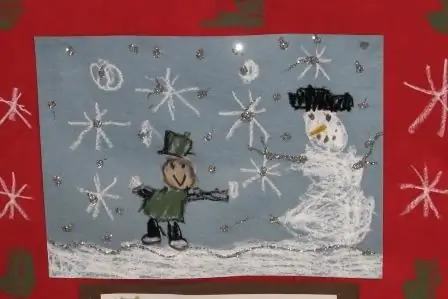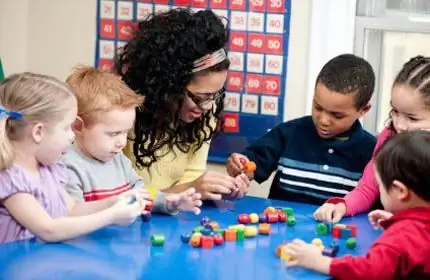2025 Author: Priscilla Miln | [email protected]. Last modified: 2025-01-22 17:55:23
Everyone knows that drawing is one of the most favorite children's activities. Toddlers in kindergarten draw with pencils, brushes, or even fingers. At school, they try to improve their skills, moving on to create more complex paintings.
However, there are also non-traditional drawing methods that are very valuable for both children and their parents. Many adults are skeptical about everything that is not included in the generally accepted framework. So, often a child is scolded for throwing a brush and starting to draw with his palms, soiling his clothes and hands. Sometimes there are situations when kids, wanting to go beyond generally accepted standards, draw, for example, on wallpaper, for which they are later punished.
These situations are not uncommon, but children should not be scolded for this. The child wants to show his attitude to the world through drawing, to try something new, to show his individuality. It's kind of an attempt to explore new activities, to learn something. So that children do not spoil the wallpaper or get dirty, but also do not limit themselves to some kind of framework, try to learn non-traditional drawing methods with them.

When unconventional drawing is applied
Fortunately, today psychologists have already established that non-traditional drawing is of great benefit to children. It helps to develop in a complex way, to look at the world from different angles. Non-traditional drawing in the preschool educational institution is already a mandatory activity, special programs have already been developed for such lessons.
At school, this technique is used much less frequently. But if a child has previously revealed creative abilities, then he does not stop there and enters an art institution.
The non-traditional drawing technique in the middle group of a preschool institution is different. There are many methods of such creativity, each of them brings joy and pleasure to children, and most importantly - benefits.
If you are interested in non-traditional drawing and want to introduce a child to it, then it is not necessary to enroll him in a particular institution. You can practice with him at home. Learn what non-traditional drawing methods are, choose the one that you and your child will like, and then start mastering it.
Blot drawing
This is one of the most popular ways to develop creative imagination in children. It also contributes to the activation of thought processes, the inclusion of the ability to think logically. Blot drawing is a way of creative self-expression. To master it, teach your child to make colorful blots on paper. After that, review the resulting art with him. Teach your child to notice various images in blots. Ask him leading questions. For example, ask your child what the drawing reminds him of and what he sees in it.
Magic blot can also turn into a full-fledged drawing. When the baby can easily say what he associates with the image on paper, you can master a more complex version of this technique. To do this, circle the blots with your child or draw some details. If you take this process seriously, you can end up with a whole plot.

Choose a large canvas
It is very useful to change the paper size. Choose a sheet that will have an elongated shape. This will help you draw together with your child, without interfering with each other. In the early stages, create separate, unrelated images. When you get used to this technique, distribute the responsibilities among yourself, which details of the drawing the child will create, and which ones are entrusted to you. The result should be a complete picture.
Working with parents inspires a child. He feels support, his importance in the creative process. This is an important component of the harmonious development of the child as an individual and part of society.
Drawing with dots
Because children love anything unusual and unconventional, dot painting will be a treat for any little one. This technique can be done with pencils and felt-tip pens placed perpendicular to a blank sheet.
However, drawing with dots is best,if you use paint. To do this, take a match, clean it of sulfur, wind cotton wool around the tip. This design will serve as your brush. Dip the cotton into the paint, dot the paper until you get the result.
Usually, the joint work of the child and parents leads to the creation of a bright and colorful picture that not only pleases all participants in the process, but also reminds of the unity of the family.
Spot drawing develops the ability to notice small things, small details that are very important. In addition, the child in the process of creativity becomes patient and diligent.

Foam rubber and die method
Most people think you need brushes and pencils to draw. This is far from true. Foam rubber is a tool that will help you make a painting class with your child that you will remember for a long time.
So that children do not get bored and realize their creative abilities, you need to make a special brush. Make different geometric shapes out of foam rubber, then attach them to pens or pencils. Next, dip your own made brushes into the paint and create a picture using stamps.
When you have mastered the initial level of this technique, let the child decide for himself what figures he wants to use in the process of drawing.
Remember that your child is just learning how to create masterpieces. Therefore, do not criticize a child's drawing. Point out its merits so that the baby has a desire to worknext.
Drawing with crayons
Regular crayons, which can be bought at any stationery store, open up a lot of opportunities for productive creativity for the child. The peculiarity of this drawing is that this method can be used on the street.
Creativity with crayons will look appropriate on asph alt, tiles and even porcelain. If it’s not raining outside, you can add new details to the composition every day, invent and develop a plot, compose entire stories based on it.
Unconventional drawing with crayons with children significantly affects the development of babies. They learn to work in an unlimited space, develop their imagination, try to think logically, and reveal their creative abilities.
This technique will bring the most results if it involves a group of adults and children. In this case, drawing will also teach the child to work in a team, without trying to direct all attention to himself.

Magic through the eyes of a child
All children believe in magic. Do not dispel this illusion, better create a real fairy tale for your child.
A child's drawing will seem more beautiful if it is created quickly, in seconds. To achieve this result, apply a drawing technique called magic.
Take a piece of wax candle, laundry soap or a pack of stationery glue and draw some image on paper with their help. Don't worry if the candle or gluewill crumble, next time choose higher quality tools.
After that, take a brush, or rather use foam rubber or cotton wool, dip the tool into the paint and apply it on the entire image in a continuous layer. Due to the fact that the texture of the drawing is oily, children's colors will fall on it differently than on paper. So you will achieve that the picture will appear literally in a matter of seconds, before your eyes.
Children are very fond of this kind of creativity, because they become real wizards. Very often, such a technique attracts a child so much that he does not stop at ordinary children's drawings, developing his skill, transferring it to adulthood.
Creating three-dimensional images
A drawing lesson is most often carried out by inviting children to create images on a plane. However, the creative process is much more interesting if the result is three-dimensional figures.
Sea pebbles are the perfect painting tool. They are so smooth that any paint falls on them evenly. The image that the child will create depends on his imagination and the shape of the stone.
Most often, with the help of this technique, non-traditional drawing of vegetables, fruits, insects, mushrooms or even animals is mastered. In the future, the pebbles can be varnished so that the memory of the work done remains forever. Most likely, the resulting toys will be useful to the child more than once, since they can participate in many children's activities.

Drawing with fingers and palms
Many parents have a negative attitude towards the child's desire to create with fingers and palms. However, this method is really good, because it gives the baby complete freedom of action.
But fingers obey children much better than brushes and pencils, so the result of such creativity is much more spectacular. It is much better if you teach your child to use not only the index finger, but all the rest, and even the palms. This will help the child discover new boundaries of creativity, develop imagination and learn to create new images.
Don't miss the opportunity to work with your kids. Collective creativity will allow the child to feel part of the team, to see their significance and importance, to join the team and realize your love. Do not worry about soiled hands or clothes, because this is not the main thing, your main task is to ensure the harmonious development of the baby.
Monotopy as original method
Monotopia is a way of extraordinary drawing, which is rarely used today. Usually, parents simply do not want to create additional difficulties for themselves by mastering a new technique. Meanwhile, the kids love the monotopic way.
The essence of the method is that you apply the image in a thick layer on cellophane, then turn it over with the pattern down and press it against the paper. The result is two images. Sometimes the drawing is printed only on paper, and sometimes it remains on cellophane.
It is the intrigue of the future result that attracts children to this technique. You have neverfind out what kind of picture you get. The process of co-creation will not only develop the imagination of children, but also give you a lot of fun.

Wet paper for blurry looks
Children often surpass adults in their desire to create. If a child wants to learn how to create, for example, fog, rain, sunset, water and similar images, then it is better to teach him to draw on wet paper.
Don't make it too wet as it may not work. It is enough to take a piece of cotton wool, moisten it with water and make the paper slightly damp. Such a canvas is suitable for creating obscure images. If your child wants to master this technique, then in the future he has a chance to become a real artist.
Drawing on fabric
Drawing on fabric is a popular art technique. Moreover, images can be created both from scratch, that is, on a piece of one shade, and finalize ready-made pictures, adding your own thoughts to ready-made elements. In the latter case, you need to stock up on multi-colored fabric.
This technique is not particularly difficult, but children really like something original and unusual. Drawings on the fabric are very bright, with clearly drawn borders. Therefore, teach your child this technique so that he improves his skills.

Drawing on crumpled paper
This technique is not difficult to master. Drawing on crumpled paper is a way thatallows you to create a mosaic effect. To use it, you need to crumple the sheet before starting creativity, and then smooth it out. The ink will appear darker where the paper is folded.
The result of such drawing is original and interesting. If a child once tries to create an image on crumpled paper, then in the future he will use this technique more than once to look at the end result.
This method of drawing is good because it involves the baby in the work for the ultimate goal, that is, it develops his perseverance and patience.
Useful drawing properties you didn't know about
Almost everyone knows that drawing develops children's imagination, logic, perseverance and patience. Collective creativity teaches to work in a team and reveals the leadership qualities of a child. However, non-traditional drawing is beneficial even in completely unexpected aspects. This technique:
- Helps develop fine motor skills of the hands, which is important for the full life of the child. This is very important in preschool education, since scientists have proven that fine motor skills are directly related to a person's ability to absorb information, remembering even minor details;
- Causes various emotions. At preschool age, it is very important to experience the full range of possible feelings and sensations. Drawing helps to feel the taste of victory and the achieved goal;
- Helps your child to express their individuality. Each person is unique, it is very important to realize this as early as possible in order to listen to your own thoughts in the future, and nottry to live a different life;
- Helps parents understand what stage of development the child is at and whether everything is in order with his psyche.
In the latter case, you need to know that at a certain age the baby should be able to create different images. A child develops harmoniously if:
- Until the age of 2, he puts various strokes on the canvas, meaningless figures in a chaotic manner;
- From 2 to 3 years old, the child still does not know how to create full-fledged images, but is already looking for meaning in his work, trying to create something specific, striving for the goal;
- From 3 to 8 years old, the child already knows how to create full-fledged images, but does not think about how they look harmoniously in the complex. That is, on one sheet of paper, he can draw the sun, a house, a car, animals, without thinking at all about the plot line of the drawing.
At a more meaningful age, children are already able to create paintings according to an invented plot. In order for this period to come as soon as possible, it is necessary to train the child's abilities. Non-traditional drawing methods will help your baby develop harmoniously. It is possible that he will be so carried away by one of the methods that it will become his hobby in the future, and perhaps his life's work.
Recommended:
Drawing: "Winter", senior group. Drawing lessons in kindergarten

Drawing: "Winter". The older group of children can draw many different landscapes in the picture. What it can be, what kind of drawing can be considered winter, details and rules - read about all this in this article
Etiquette rules for children of preschool and school age. Etiquette lessons for kids

Teaching children to be polite is essential from an early age. It depends on how well the child will fit into modern society, how quickly he will master the business ethics that he will need in the future. The rules of etiquette for children have been worked out by many psychologists, but it is the parents who have to present them
Swollen fingers during pregnancy: symptoms, methods for solving the problem and advice from doctors

Pregnancy is accompanied not only by pleasant moments, but also by very uncomfortable phenomena. One of them is swelling of the fingers, which occurs in more than half of pregnant women. That is why the fair sex is interested in ways to combat swelling of the upper limbs and preventive measures
Placenta accreta: symptoms, causes, diagnostic methods, possible risks for mother and child, treatment methods and recommendations from gynecologists

The placenta is an embryonic organ that allows the fetus to receive oxygen and nutrition during pregnancy. In the normal state of the woman and the correct course of pregnancy, the placenta is attached at the top of the uterus and remains there until the very time of childbirth. After the birth of a child, it exfoliates from the wall of the uterus and comes out
The Tale of the Snow Maiden, or Safety Lessons for Your Kids

Winter in children is associated with snow, sleds, snowballs, Santa Claus and his beautiful granddaughter Snegurochka. At this time, New Year's miracles traditionally happen, long-awaited gifts materialize under the tree. And in the evenings it’s good to get together with the whole family and listen to fairy tales about the Snow Maiden. With their help, children in an unobtrusive way will learn a number of important lessons

